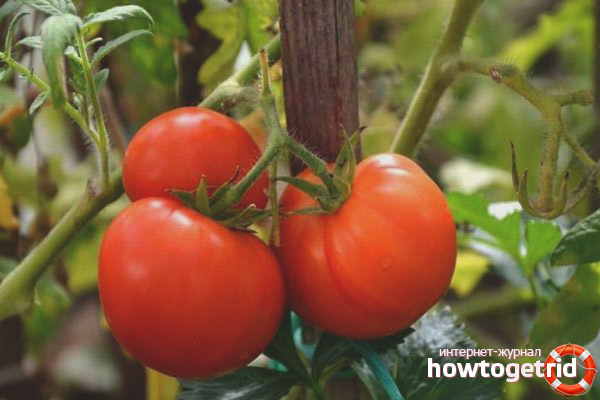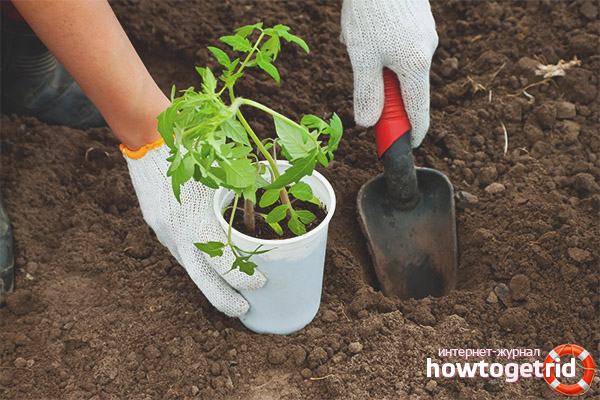The content of the article
Kolkhozny Tomato is a determinant, high-yielding vintage variety. It is grown mainly in open ground. Low branched bushes practically do not need to be tied up and formed. The variety is resistant to viral diseases of tomatoes and apical rot. The fruits do not crack, have a red juicy pulp and dense skin.
Description
The collective farm variety is one of the most productive varieties of tomatoes for open ground. The plant is spreading, stocky, completely covered with ripening fruits. The leaves are saturated green. Fruits are rounded, with dense skin, all the same size.
Ripe fruits are perfectly transported over long distances. Rural residents are very fond of this variety of tomatoes for their unpretentiousness and high productivity, as well as the fact that they can be used to collect seeds for cultivation in subsequent years on their plots. Tomatoes canning, moonlighting on juice, pasta, ketchup. Tomatoes of the collective farm variety are also good for pickling.
Cultivation and care
If it is possible to provide good lighting, tomato seeds can be planted in boxes at the end of February. In its absence, it is better to transfer the sowing to the beginning of March, since the presence of sunlight greatly affects the growth and strength of seedlings.
- Before planting, seeds are recommended to be disinfected in a solution of potassium permanganate. Since the seeds are small, they should not be covered with soil. The best option would be if, after watering the soil well, sow them on top, and then cover with film. This is necessary to avoid the loss of moisture that is needed for germination.
- After that, spraying from the spray gun should be done every day, as ordinary watering will wash all the seeds. If the temperature is in the range of 20-22 degrees, then with this care, shoots will appear after 5-7 days, which you must also continue to care for.
- As you grow, you should increasingly open the film, allowing the sprouts to get used to environmental conditions. You should start once a day for a period of not more than 10 minutes, increasing this time every week. After the seedlings have grown stronger and the first leaves have grown, it will be possible to completely remove the film and pick.
Planting seedlings in the ground
Seedlings are best transplanted on cloudy days or in the evening. When transplanting from a pot to a permanent place, make sure that the soil is fine. Since tomatoes are often susceptible to various fungal diseases, it is important to decontaminate the soil from diseases before transplanting.
- Do not forget about good drainage, otherwise the plants can quickly turn yellow leaves and rot the roots. The acidity of the soil should be practically neutral (pH 5.5-6.5).
- The universal soil for the Kolkhozny variety is a natural mixture of peat with the addition of organic substances. However, even in this case, as plants grow, regular plant nutrition is necessary. This is especially true if the plant will grow in a small container, where the supply of nutrients needed by the plant is quickly depleted.
- Since, with good development of seedlings, the roots of the plant usually wrap tightly around an earthen lump in a pot, when transplanting, to reduce the trauma of the root system, it is better to take the entire earthen lump. This method will provide better survival, rapid growth and abundant flowering.
All tomatoes are very fond of warmth and light. Moreover, the larger the fruits, the more heat-loving the plant. In wet and cold weather, tomatoes can get late blight, they can even rot.
Outdoor Care
In order for the tomatoes to grow well in the open ground, the bushes need to be planted at a distance of at least 40 cm between them.
- After transplanting to a permanent place, to enhance the formation of buds, you will need to constantly loosen the soil, and make sure that the earth is moist.
- It is also important to timely feed the plant. The first time fertilizers are applied already a week after planting, and then every two weeks. Usually, mineral complex fertilizers are used for feeding.
- To form a bush, pinch the plant already at an early stage of development (usually above 4-5 leaves), this technique allows you to increase the number of side branches and buds. In a more adult state, if the bush is very long, you can trim to 2/3 of the shoot, which will enhance its further growth and budding.
The collective farm variety will delight the crop in any weather. Round juicy fruits of the same size can be consumed fresh, as well as used for making pickles for the winter.
Video: collective farm tomatoes











Submit